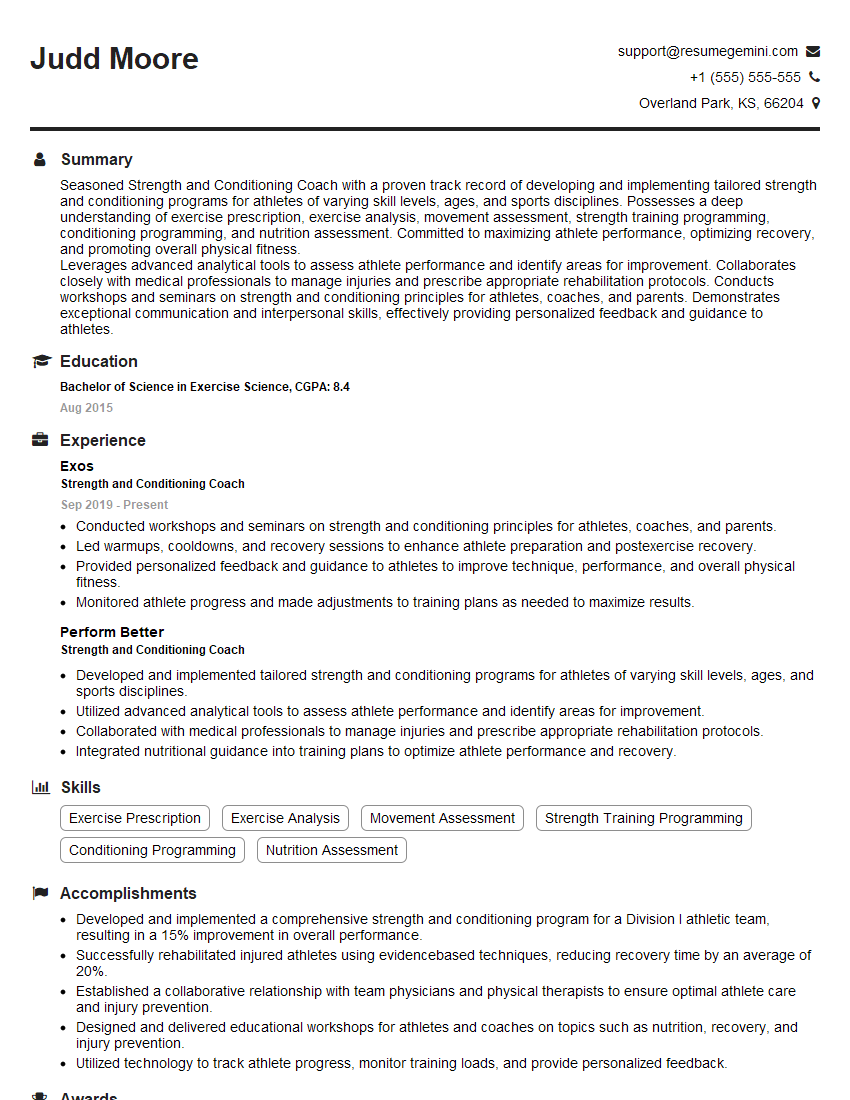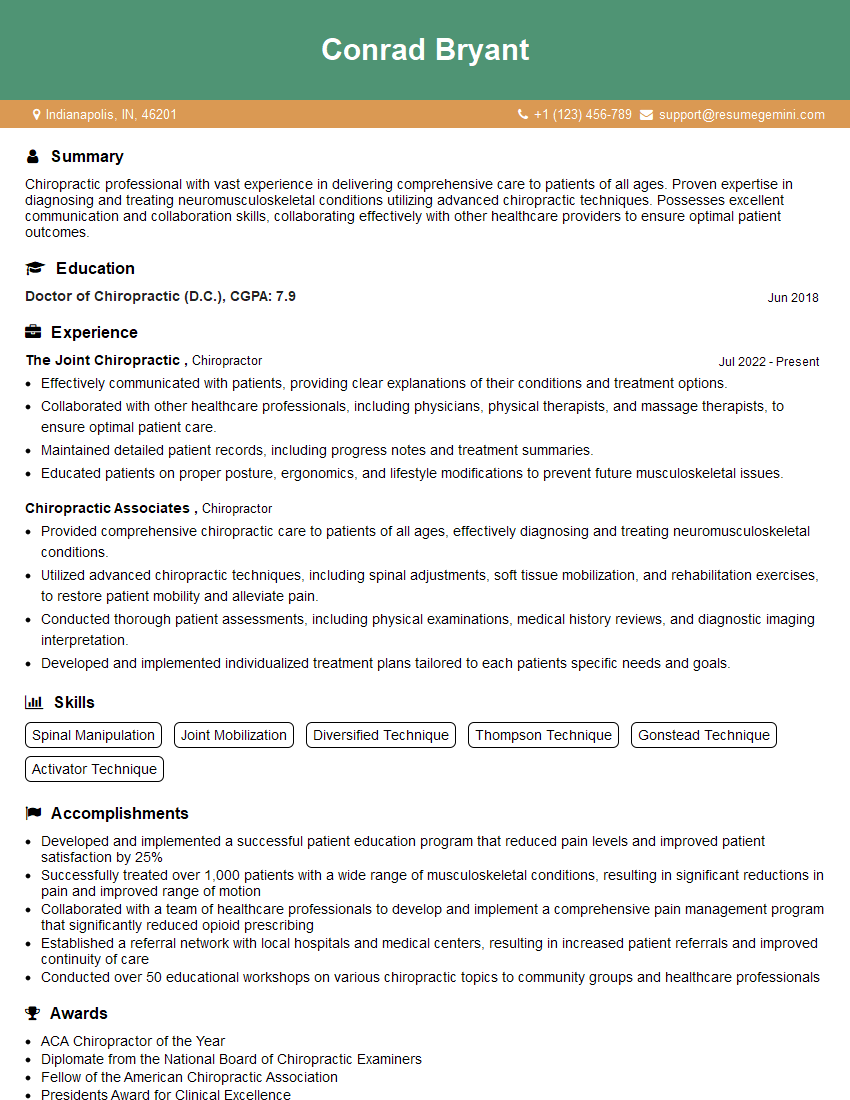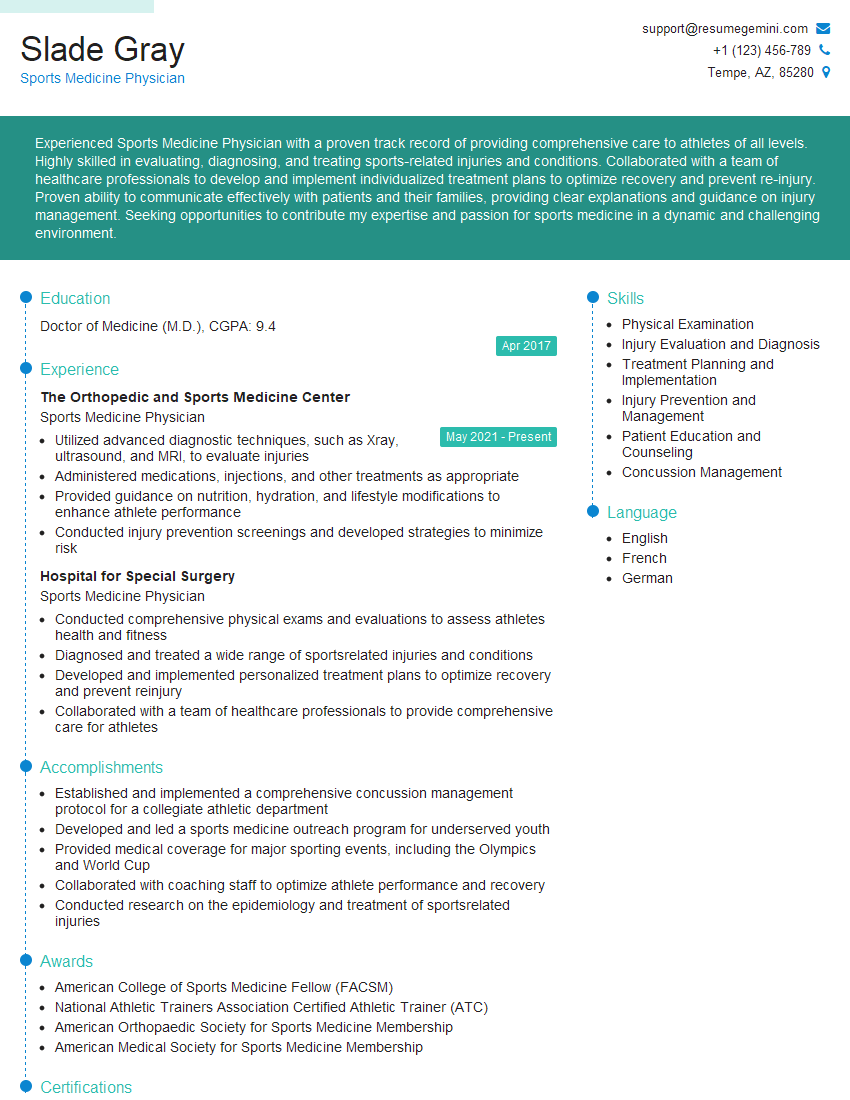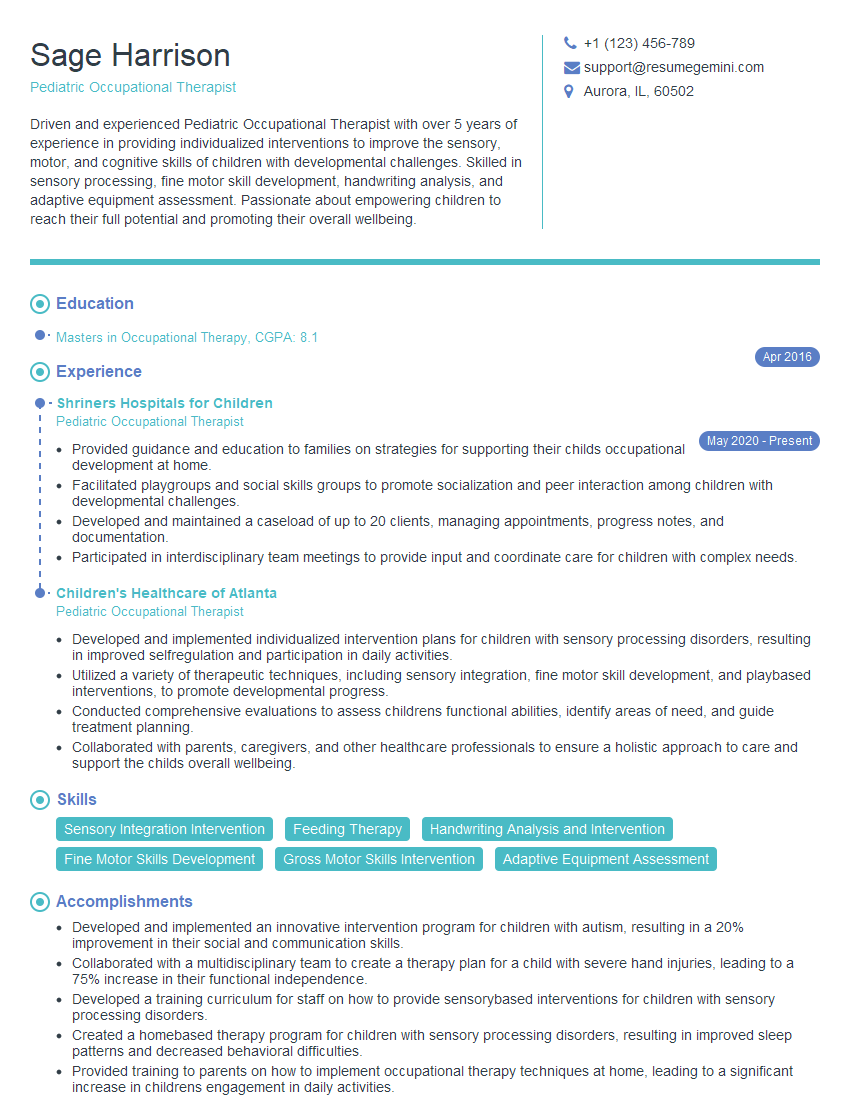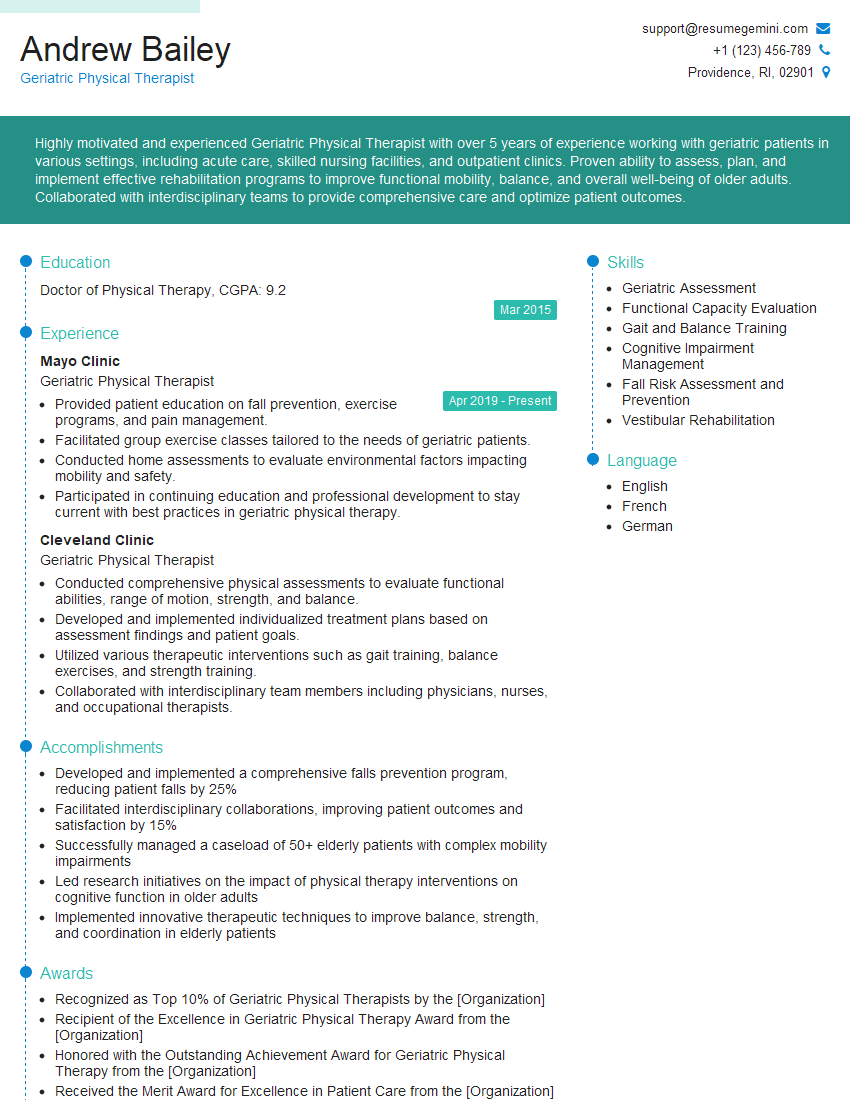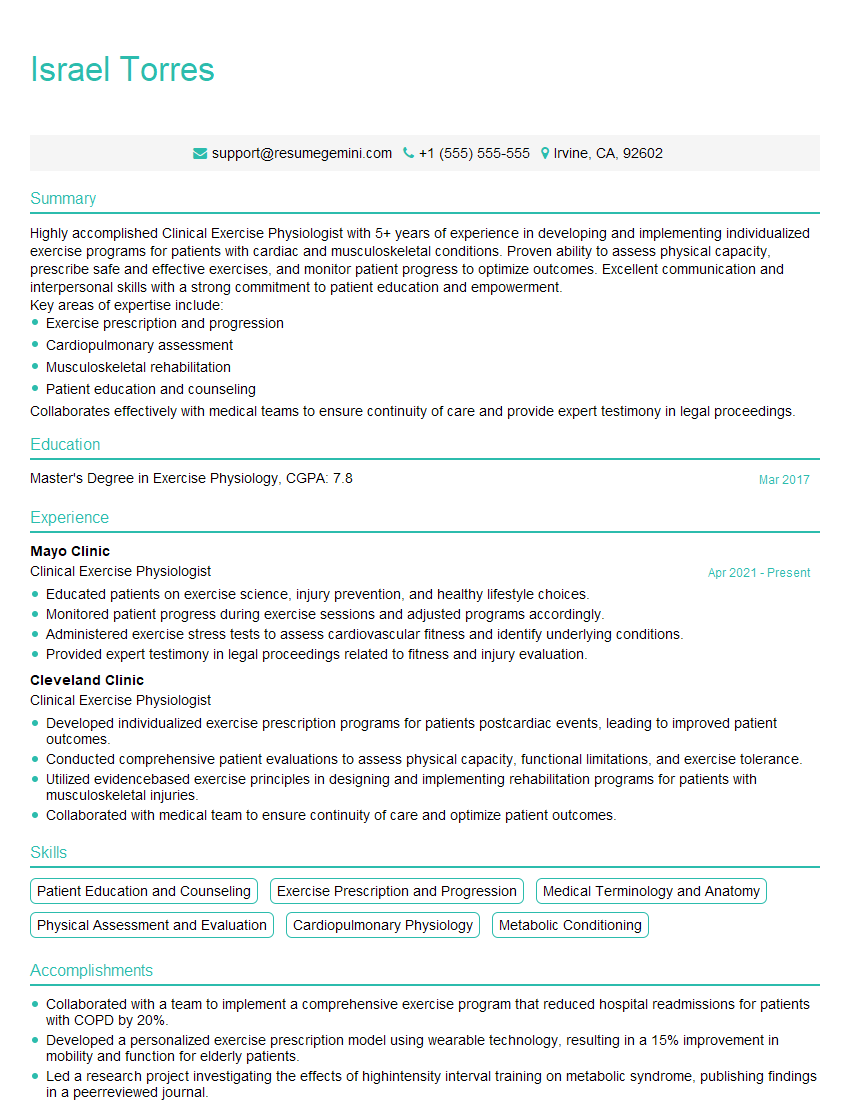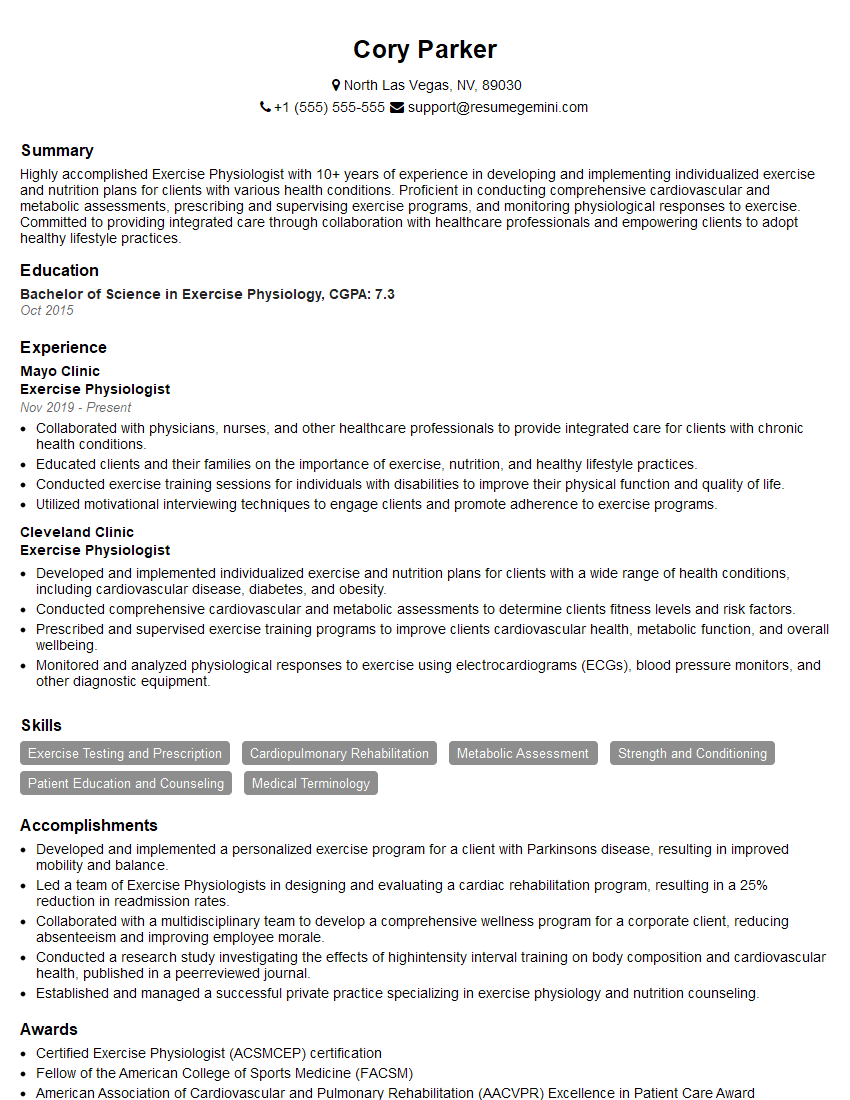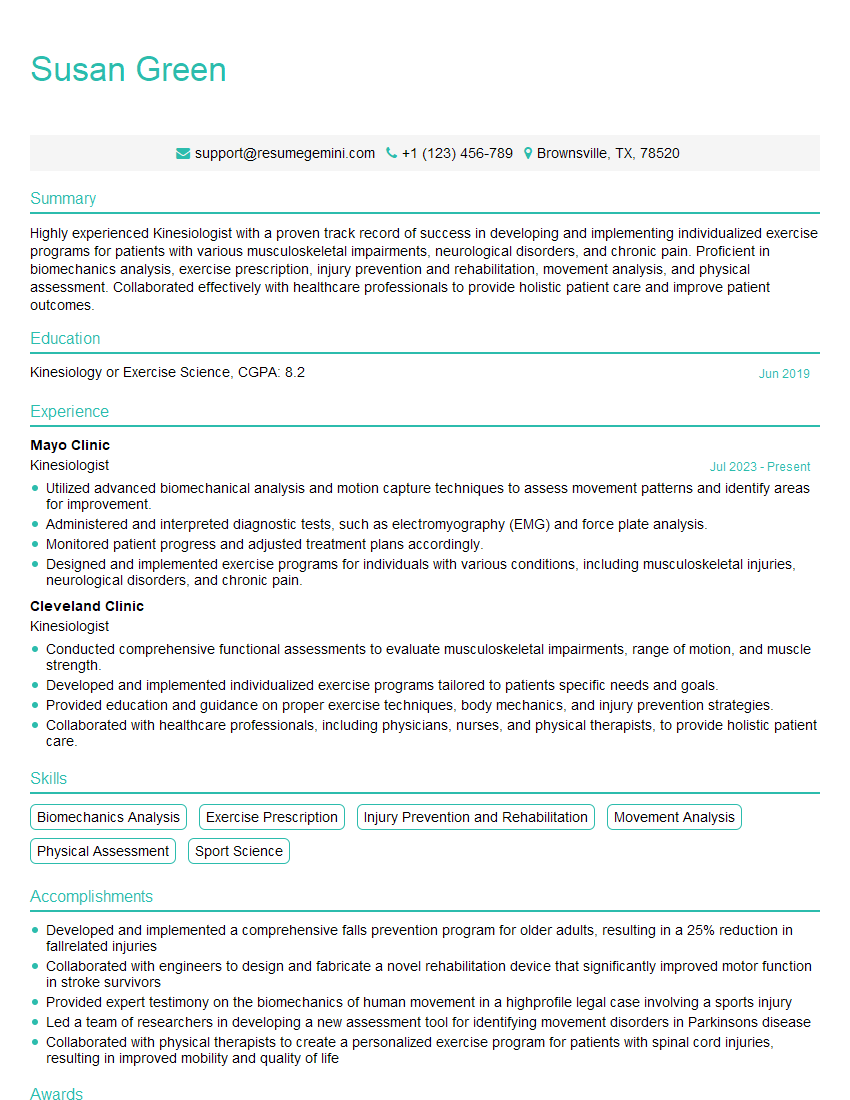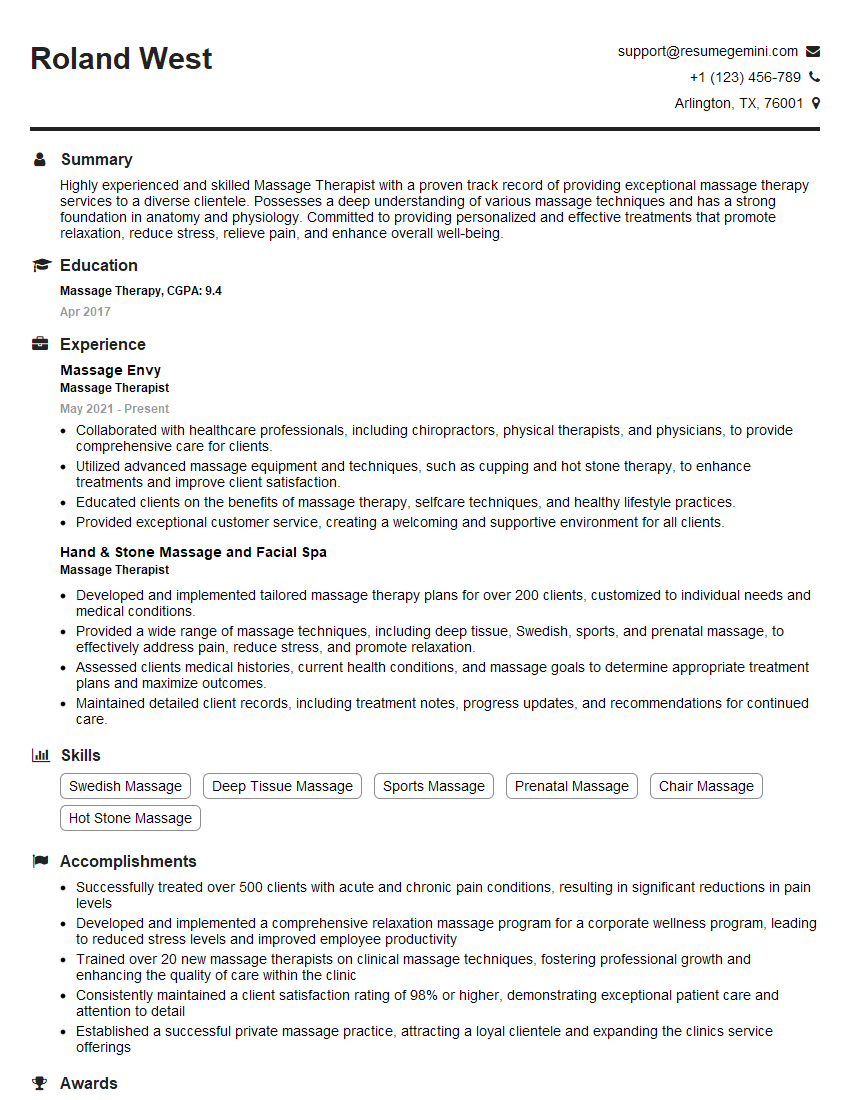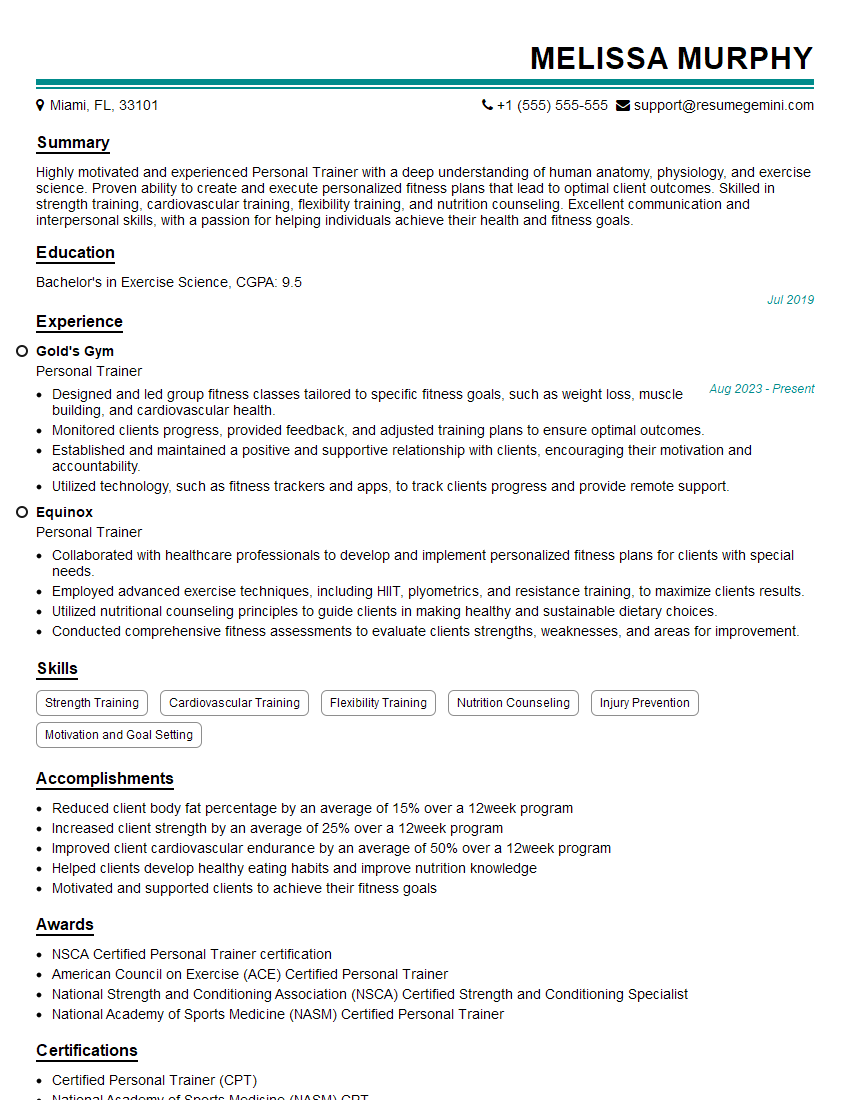Feeling uncertain about what to expect in your upcoming interview? We’ve got you covered! This blog highlights the most important Physical Health and Dexterity interview questions and provides actionable advice to help you stand out as the ideal candidate. Let’s pave the way for your success.
Questions Asked in Physical Health and Dexterity Interview
Q 1. Explain the difference between Type I and Type II muscle fibers.
Skeletal muscles contain two main types of muscle fibers: Type I and Type II. These differ primarily in their contractile speed, energy source, and fatigue resistance. Think of them as two different teams of athletes: one built for endurance, the other for short bursts of intense power.
- Type I (Slow-twitch): These fibers are slow to contract but highly resistant to fatigue. They rely on aerobic metabolism (using oxygen) for energy, making them ideal for sustained activities like long-distance running or maintaining posture. They have a high capillary density (lots of tiny blood vessels) to supply oxygen efficiently.
- Type II (Fast-twitch): These fibers contract rapidly and generate more force, but they fatigue quickly. They primarily use anaerobic metabolism (without oxygen) for energy, making them suited for short, intense activities like sprinting or weightlifting. They are further subdivided into Type IIa (intermediate) and Type IIb (fastest) based on their metabolic properties.
Understanding this distinction is crucial in exercise prescription. Endurance athletes might benefit from training that emphasizes Type I fiber recruitment, while power athletes need to focus on Type II fiber training. It’s important to note that most individuals possess a mixture of both fiber types, with the proportion varying depending on genetics and training history.
Q 2. Describe the principles of proper body mechanics.
Proper body mechanics involve using your body in a way that minimizes strain and maximizes efficiency. Imagine it as a well-oiled machine – each part working in harmony to achieve a task safely and effectively. The core principles include:
- Maintain a stable base of support: Keep your feet shoulder-width apart and maintain a balanced stance.
- Use your legs and core muscles: Avoid bending only at your waist when lifting; instead, bend at your knees and hips, keeping your back straight and using your leg muscles to lift.
- Keep objects close to your body: This reduces strain on your back and reduces the leverage needed to lift and move objects.
- Avoid twisting or reaching: These movements can overstress your spine and muscles.
- Lift smoothly and avoid jerky movements: Sudden movements put unnecessary stress on your body.
- Plan your movements: Before you lift, move, or reach, assess the situation and plan your actions to ensure you’re using proper technique.
For example, when lifting a heavy box, you shouldn’t bend at the waist. Instead, squat down, keeping your back straight, grip the box firmly, and lift using your leg muscles, keeping the box close to your body. Proper body mechanics are essential in preventing injuries such as back pain, muscle strains, and sprains in various daily activities and professional settings like nursing or construction.
Q 3. What are the common causes of carpal tunnel syndrome?
Carpal tunnel syndrome (CTS) is a condition that causes numbness, tingling, and pain in the hand and forearm. It occurs when the median nerve, which runs through the carpal tunnel in your wrist, becomes compressed. Several factors can contribute to this compression:
- Repetitive hand movements: Activities like typing, assembly line work, or playing certain musical instruments can repeatedly flex the wrist, narrowing the carpal tunnel and compressing the median nerve.
- Wrist injuries: Fractures, sprains, or dislocations can cause inflammation and swelling, leading to nerve compression.
- Fluid retention: Conditions like pregnancy, hypothyroidism, or rheumatoid arthritis can cause fluid retention, increasing pressure within the carpal tunnel.
- Anatomical variations: Some people are born with a smaller carpal tunnel, making them more susceptible to CTS.
- Long-term exposure to vibration: Workers using vibrating tools are at increased risk.
Think of the carpal tunnel as a narrow passageway. Any swelling or narrowing of this passageway increases pressure on the median nerve, resulting in the characteristic symptoms of CTS.
Q 4. How would you assess a patient’s range of motion?
Assessing a patient’s range of motion (ROM) involves systematically measuring the extent of movement at a particular joint. This helps identify limitations in movement, diagnose injuries, and track progress in rehabilitation. Several methods exist:
- Goniometry: This uses a goniometer, a two-armed instrument, to measure the angle of a joint’s movement. The protractor measures the degrees of flexion, extension, abduction, and adduction, etc. It’s precise but requires training.
- Visual estimation: This involves visually observing the patient’s joint movement and comparing it to normal ROM. While less precise, it’s useful for quick assessments.
- Observation of functional movements: Assessing ROM during activities like reaching overhead, bending, or walking provides a functional perspective.
- Patient report: Subjective reporting from the patient about their perceived limitations should always be considered.
For instance, to assess elbow flexion, the patient would bend their elbow as much as possible while the examiner uses a goniometer to measure the angle. Comparing this angle to the normal range for elbow flexion helps determine the extent of any limitation.
Q 5. Explain the importance of ergonomic workstation setup.
Ergonomic workstation setup is crucial for preventing musculoskeletal disorders and promoting comfort and productivity. A properly set-up workstation reduces strain on the body by minimizing awkward postures and repetitive movements. Key aspects include:
- Chair: Should provide proper lumbar support, adjustable height, and armrests.
- Desk: Should be at a height that allows for typing with elbows at a 90-degree angle and wrists straight.
- Monitor placement: Should be positioned directly in front of the user at eye level to avoid neck strain.
- Keyboard and mouse placement: Should be positioned close to the body to avoid reaching and straining.
- Lighting: Should be adequate to avoid eye strain.
- Breaks: Regular breaks are essential to avoid prolonged static postures.
Imagine spending 8 hours a day in a poorly set-up workstation. This can lead to neck pain, back pain, carpal tunnel syndrome, and other musculoskeletal problems. A properly ergonomically designed workstation prevents these problems, allowing for comfort and high productivity.
Q 6. What are the benefits of regular exercise for cardiovascular health?
Regular exercise significantly improves cardiovascular health. A healthy cardiovascular system is essential for delivering oxygen and nutrients throughout the body. The benefits include:
- Improved heart function: Exercise strengthens the heart muscle, allowing it to pump blood more efficiently.
- Lowered blood pressure: Regular physical activity helps regulate blood pressure, reducing the risk of hypertension.
- Reduced cholesterol levels: Exercise helps raise high-density lipoprotein (HDL, “good” cholesterol) and lower low-density lipoprotein (LDL, “bad” cholesterol).
- Weight management: Exercise helps burn calories and maintain a healthy weight, reducing the risk of obesity-related cardiovascular diseases.
- Improved blood sugar control: Physical activity increases insulin sensitivity, improving blood sugar regulation and reducing the risk of type 2 diabetes.
- Reduced risk of heart disease, stroke, and other cardiovascular diseases: The combined effects of these improvements significantly reduce the risk of developing these serious conditions.
Think of your heart as a muscle. Like any muscle, it benefits from regular exercise to become stronger and more efficient. A stronger heart can handle more stress, improving overall cardiovascular health.
Q 7. Describe different types of stretching techniques and their applications.
Stretching techniques are crucial for improving flexibility, range of motion, and injury prevention. Different techniques target different needs:
- Static stretching: Holding a stretch in a comfortable position for a sustained period (e.g., 15-30 seconds). This is ideal for improving flexibility and relaxation. Example: Holding a hamstring stretch by extending your leg.
- Dynamic stretching: Involves controlled movements through a range of motion. This is ideal for warming up before activity. Example: Arm circles or leg swings.
- Ballistic stretching: Uses bouncing movements to increase range of motion. It’s more forceful and potentially risky for injury and therefore generally avoided.
- Proprioceptive neuromuscular facilitation (PNF): Involves contracting muscles before stretching, increasing flexibility. This is usually done with a partner and requires training. Example: A partner resists a muscle contraction before relaxing and stretching the muscle.
- Isometric stretching: Involves holding a muscle contraction in a stretched position. Example: Pushing against a wall while maintaining a stretch in your arms.
The choice of stretching technique depends on the individual’s goals, fitness level, and the specific muscle groups being targeted. For example, static stretching is perfect for post-workout cool-downs, while dynamic stretching is ideal for warming up before exercise.
Q 8. How would you design a rehabilitation program for a patient with a knee injury?
Designing a knee injury rehabilitation program requires a phased approach, starting with pain management and progressing to full functional restoration. The specific program will depend heavily on the nature and severity of the injury (e.g., ligament tear, meniscus injury, osteoarthritis).
Phase 1: Initial Healing (Weeks 1-4): This phase focuses on reducing pain and inflammation. It typically involves rest, ice, compression, and elevation (RICE protocol). Gentle range-of-motion exercises are introduced to prevent stiffness, but avoiding any movements that cause pain. Crutches or other assistive devices may be used.
Phase 2: Strengthening and ROM (Weeks 4-8): Once pain and inflammation subside, we focus on regaining range of motion and strengthening the muscles surrounding the knee. This might involve exercises like isometric contractions (holding the muscle in a contracted state), isotonic exercises (lifting weights or using resistance bands), and low-impact cardiovascular activities like cycling or swimming. Therapists might use modalities like ultrasound or electrical stimulation to promote healing.
Phase 3: Functional Training (Weeks 8-12+): This phase focuses on regaining functional movement patterns. Patients gradually increase the intensity and complexity of their exercises, focusing on activities like squats, lunges, and stair climbing. Proprioceptive training (balance and coordination exercises) is crucial to improve stability and prevent re-injury. The patient would eventually progress to sport-specific exercises if appropriate.
Phase 4: Return to Activity (Ongoing): This involves a gradual return to normal activity levels, ensuring the patient is able to perform everyday tasks and recreational activities without pain or discomfort. Regular monitoring and adjustments to the program may be necessary.
Throughout all phases, patient education is paramount. Patients need to understand the injury, the rehabilitation process, and how to modify their activities to prevent future injuries. A tailored program, regular assessments, and close communication between the patient and therapist are essential for successful rehabilitation.
Q 9. Explain the concept of proprioception and its role in injury prevention.
Proprioception is your body’s awareness of its position and movement in space. It’s that ‘sixth sense’ that allows you to know where your limbs are without looking. It’s a complex system involving sensory receptors in muscles, tendons, joints, and skin, which send signals to the brain. This information helps maintain balance, coordinate movement, and adjust posture.
In injury prevention, strong proprioception is crucial. Good proprioception means your body can quickly detect and respond to unexpected changes in position or balance. For example, if you trip, your body can instantly make adjustments to prevent a fall. Conversely, poor proprioception increases the risk of injury because your body is less able to react to destabilizing forces. Weakness, injury, or lack of use can all impair proprioception.
We can improve proprioception through exercises that challenge balance and coordination, such as:
- Standing on one leg with eyes closed
- Balance board exercises
- Agility drills
- Activities on unstable surfaces (e.g., foam pads)
These exercises help the nervous system learn to better interpret sensory input and make appropriate motor responses, enhancing stability and reducing injury risk. Think of it like training a muscle: the more you challenge your proprioceptive system, the stronger and more responsive it becomes.
Q 10. What are the signs and symptoms of a concussion?
Concussions are traumatic brain injuries caused by a bump, blow, or jolt to the head or body. They disrupt normal brain function, and symptoms can vary widely in severity and duration. It’s crucial to remember that the absence of immediate symptoms doesn’t rule out a concussion.
Common Signs and Symptoms:
- Physical: Headache, dizziness, nausea, vomiting, balance problems, blurred vision, sensitivity to light or noise.
- Cognitive: Confusion, slowed thinking, difficulty concentrating, memory problems, difficulty remembering events before or after the injury.
- Emotional: Irritability, sadness, anxiety, emotional lability (rapid mood swings).
- Sleep disturbances: Difficulty sleeping, sleeping more or less than usual.
Important Note: These symptoms can appear immediately after the injury or develop later. Some individuals may experience a period of seeming normalcy before symptoms emerge (lucid interval). A thorough evaluation by a medical professional is necessary for proper diagnosis and management. Delaying diagnosis and treatment could lead to prolonged symptoms or more severe complications.
Q 11. How would you assess a patient’s balance and coordination?
Assessing a patient’s balance and coordination involves a combination of observation and standardized tests. The assessment should consider age, medical history, and the reason for the assessment.
Observational Assessment: We start by observing the patient’s gait (walking pattern), posture, and movement during functional activities like standing, sitting, and turning. We look for any signs of instability, tremors, or abnormal movements.
Standardized Tests: Several standardized tests are used to quantify balance and coordination, including:
- Romberg test: Assesses static balance by observing the patient’s ability to stand with feet together, eyes closed.
- Single-leg stance test: Measures static balance by assessing the time a patient can stand on one leg with eyes open and closed.
- Functional reach test: Evaluates dynamic balance by measuring how far the patient can reach forward without losing balance.
- Timed Up and Go (TUG) test: Assesses mobility and balance by timing the patient’s ability to stand up from a chair, walk 3 meters, turn, walk back, and sit down.
- Coordination tests: Such as finger-to-nose test, heel-to-shin test, and rapid alternating movements, assess the coordination and smoothness of movements.
The choice of tests depends on the patient’s condition and the goals of the assessment. The results are interpreted in context with the patient’s history and other findings to determine the level of impairment and guide treatment planning.
Q 12. What are the different types of assistive devices and when would you recommend them?
Assistive devices are tools designed to improve mobility, independence, and safety for individuals with physical limitations. The choice of device depends entirely on the individual’s needs and condition.
Types of Assistive Devices:
- Canes: Provide additional support and stability during walking, reducing stress on joints. Used for mild balance impairments or weakness in one leg.
- Walkers: Offer more support than canes, providing a wider base of support and increased stability. Useful for individuals with significant balance problems or weakness in both legs.
- Crutches: Used for temporary support following surgery or injury, allowing weight-bearing to be reduced or eliminated on one or both legs.
- Wheelchairs: Provide mobility for individuals who cannot walk safely or independently. Manual wheelchairs are propelled by the user, while power wheelchairs use batteries for propulsion.
- Orthoses (Braces): Provide support and stability to weakened joints or limbs. They are custom-fitted to address specific needs.
When to Recommend Assistive Devices: The decision to use an assistive device is made on a case-by-case basis, considering:
- The patient’s level of mobility and balance.
- The presence of pain or weakness.
- The risk of falls.
- The patient’s ability to use the device safely and effectively.
Proper fitting and training on how to use the assistive device are crucial to ensure safety and effectiveness. A physical therapist or occupational therapist can guide this process.
Q 13. Describe the process of muscle hypertrophy and its relationship to strength gain.
Muscle hypertrophy refers to an increase in the size of muscle fibers. This is achieved through a process called muscle protein synthesis, where the body builds new muscle proteins to repair and rebuild muscle tissue following resistance training. This increased muscle mass directly contributes to strength gains.
The process involves several steps:
- Muscle damage: Resistance training causes microscopic tears in muscle fibers.
- Inflammation: The body’s inflammatory response is triggered to initiate the repair process.
- Protein synthesis: Amino acids (the building blocks of protein) are used to synthesize new muscle proteins, leading to the growth of muscle fibers.
- Hypertrophy: The result is an increase in the size and number of myofibrils (the contractile elements within muscle fibers), leading to overall muscle growth (hypertrophy).
The relationship between muscle hypertrophy and strength gain is strong but not perfectly linear. Larger muscles generally produce more force, leading to increased strength. However, factors like neuromuscular adaptations (improved coordination between nerves and muscles) and increased motor unit recruitment (activation of more muscle fibers) also contribute significantly to strength gains.
Think of it like building a house: hypertrophy is increasing the size of the bricks (muscle fibers), while neuromuscular adaptations are improving the overall structure and efficiency of the house, making it stronger and more capable of withstanding stress.
Q 14. Explain the role of nutrition in muscle recovery and growth.
Nutrition plays a vital role in muscle recovery and growth. Providing the body with the necessary nutrients is crucial for optimal muscle protein synthesis and repair.
Macronutrients:
- Protein: Essential for building and repairing muscle tissue. Aim for adequate protein intake, typically 1.6-2.2 grams per kilogram of body weight for those engaging in resistance training.
- Carbohydrates: Provide the body with energy to fuel workouts and replenish glycogen stores (energy stored in muscles). Consume carbohydrates before, during, and after workouts.
- Fats: Important for hormone production and overall health. Choose healthy fats like avocados, nuts, and olive oil.
Micronutrients: Vitamins and minerals are also important for muscle growth and recovery. These include:
- Creatine: A naturally occurring compound that can improve muscle strength and power.
- Vitamin D: Plays a role in muscle protein synthesis and function.
- Iron: Essential for oxygen transport to muscles.
Hydration: Adequate hydration is crucial for muscle function and recovery. Dehydration can impair performance and increase the risk of muscle cramps.
Timing of nutrient intake is also important. Consuming protein and carbohydrates after a workout helps replenish glycogen stores and stimulate muscle protein synthesis. A balanced diet that provides all the necessary nutrients is essential for optimal muscle growth and recovery.
Imagine your muscles as a construction site: protein is the building material, carbohydrates are the fuel for the construction workers, and micronutrients and hydration ensure a smooth and efficient construction process.
Q 15. How do you prevent overuse injuries in athletes?
Preventing overuse injuries in athletes hinges on a holistic approach encompassing proper training techniques, adequate rest and recovery, and injury prevention strategies. Think of it like this: a car engine needs regular maintenance to avoid burnout; similarly, an athlete’s body needs careful management to withstand the demands of training.
- Gradual Progression of Training Load: Avoid sudden increases in training intensity, duration, or frequency. This principle, often called progressive overload, allows the body to adapt gradually, minimizing stress and injury risk. For instance, a runner shouldn’t increase their mileage by 50% in one week. A gradual increase of 10% per week is far safer.
- Proper Warm-up and Cool-down: Warm-up routines prepare the muscles and joints for activity, improving blood flow and flexibility. Cool-down exercises help reduce muscle soreness and promote recovery. Imagine preparing a cake – you wouldn’t just throw all the ingredients together without preheating the oven!
- Appropriate Technique: Correct technique minimizes strain on joints and muscles. Working with a coach or physical therapist to refine technique in sports like swimming, running, or weightlifting can be extremely beneficial. Poor form can lead to repetitive stress injuries easily.
- Adequate Rest and Recovery: Allowing the body sufficient time to recover is crucial. Overtraining can significantly increase injury risk. This involves incorporating rest days, active recovery (like light swimming or cycling) and getting sufficient sleep.
- Strength and Conditioning: Incorporating strength training, flexibility exercises, and plyometrics into training regimes helps to build muscle strength, balance, and improve joint stability, reducing vulnerability to injuries.
- Nutrition and Hydration: Proper nutrition and hydration are fundamental for muscle repair and overall health. A balanced diet providing sufficient protein, carbohydrates and micronutrients is crucial for supporting demanding training.
Career Expert Tips:
- Ace those interviews! Prepare effectively by reviewing the Top 50 Most Common Interview Questions on ResumeGemini.
- Navigate your job search with confidence! Explore a wide range of Career Tips on ResumeGemini. Learn about common challenges and recommendations to overcome them.
- Craft the perfect resume! Master the Art of Resume Writing with ResumeGemini’s guide. Showcase your unique qualifications and achievements effectively.
- Don’t miss out on holiday savings! Build your dream resume with ResumeGemini’s ATS optimized templates.
Q 16. What are some common musculoskeletal disorders and their treatments?
Musculoskeletal disorders (MSDs) affect the muscles, bones, joints, tendons, and ligaments. These conditions are incredibly common, often stemming from overuse, trauma, or underlying health issues.
- Carpal Tunnel Syndrome: Compression of the median nerve in the wrist, causing pain, numbness, and tingling. Treatment often involves wrist splints, medication, or surgery in severe cases.
- Tendinitis: Inflammation of a tendon, often caused by repetitive movements. Rest, ice, compression, elevation (RICE), physical therapy, and anti-inflammatory medications are common treatments.
- Osteoarthritis: Degeneration of joint cartilage, causing pain, stiffness, and reduced range of motion. Management typically involves weight loss, physical therapy, medication, and sometimes joint replacement surgery.
- Rotator Cuff Injuries: Tears or inflammation of the muscles and tendons surrounding the shoulder joint. Treatment depends on severity, ranging from rest and physical therapy to surgery.
- Back Pain (various causes): A broad category encompassing various conditions like muscle strains, disc herniations, and spinal stenosis. Treatment options range from conservative approaches such as exercise, pain relief medication and physical therapy, to surgical interventions in severe cases.
Remember that proper diagnosis is crucial before initiating any treatment. A healthcare professional should always be consulted to determine the underlying cause and develop a personalized treatment plan.
Q 17. What are the different types of joint injuries and how are they diagnosed?
Joint injuries vary widely in type and severity. Accurate diagnosis is crucial for effective treatment and relies on a combination of physical examination, imaging techniques (X-rays, MRI, CT scans), and sometimes arthroscopy (a minimally invasive surgical procedure).
- Sprains: Ligament injuries, ranging from mild stretching to complete tears. Severity is graded I-III. Treatment involves RICE and potentially physical therapy or surgery for severe sprains.
- Strains: Muscle or tendon injuries, also graded I-III in severity. Treatment is similar to sprains, focusing on rest and gradual rehabilitation.
- Dislocations: Displacement of a bone from its joint. Requires immediate medical attention for reduction (realignment) and often immobilization.
- Fractures: Bone breaks. Diagnosis is usually through X-ray, treatment varies significantly depending on location, type and severity, ranging from immobilization with casts to surgical fixation.
- Cartilage Injuries: Damage to the cartilage cushioning the joints. Often diagnosed through MRI and may require arthroscopic surgery or other advanced treatments.
The symptoms can overlap, so a comprehensive assessment by a healthcare professional is essential for definitive diagnosis and management.
Q 18. Describe the stages of wound healing.
Wound healing is a complex process with several overlapping phases. It’s like building a house: you need a strong foundation (inflammation), a sturdy structure (proliferation), and a beautiful finish (maturation).
- Hemostasis (Immediate): Blood clotting stops bleeding. Think of this as sealing the wound to prevent further blood loss. Platelets play a critical role.
- Inflammation (1-10 days): The body’s response to injury, characterized by redness, swelling, pain, and heat. White blood cells fight infection and start the cleanup process. This is analogous to the demolition phase of construction, removing damaged tissues.
- Proliferation (3-21 days): New tissue formation, including granulation tissue (a pink, granular tissue filling the wound). Angiogenesis (formation of new blood vessels) and collagen production (strengthens the wound) occur during this phase. This is like building the frame and walls of the house.
- Maturation (21 days – years): Remodeling of the scar tissue, collagen is rearranged for strength and flexibility. The scar gradually fades but may never fully disappear. This is the finishing stage – adding fixtures, landscaping, etc.
Factors such as wound size, location, infection, and overall health can influence the healing time.
Q 19. Explain the principles of applying Kinesio tape.
Kinesio taping is a therapeutic technique using elastic adhesive tape to support muscles, reduce pain, and improve joint function. It’s not about restricting movement but rather providing support and facilitating natural movement.
- Skin Preparation: Clean and dry the skin. Hair removal may be necessary for optimal adhesion.
- Tape Application: Tape is applied with varying degrees of tension depending on the desired effect. There are specific techniques, for muscle support, for lymphatic drainage and for pain relief. Proper application is crucial to avoid skin irritation or restricted movement.
- Anchoring: The tape ends are securely anchored to provide stability. The anchoring technique varies depending on the specific application.
- Overlap: The tape strips are overlapped for better adherence and support.
- Tension: The amount of tension applied depends on the treatment goal and can impact the amount of skin lifting or muscle support. Correct tension is key for effective treatment.
Kinesio taping is a skill best learned through proper training and certification. Improper application can be ineffective or even counterproductive. It should be done by a qualified healthcare professional or trained practitioner.
Q 20. What are some common complications of surgery?
Surgical complications can range from minor to life-threatening. The risk of complications depends on factors such as the type of surgery, patient health, and surgical expertise.
- Infection: A common complication that can delay healing and lead to more serious problems. Prevention involves proper surgical techniques and antibiotic prophylaxis.
- Bleeding: Excessive bleeding can cause blood loss and require further intervention.
- Blood clots (thrombosis): Can occur in the legs or lungs, potentially causing serious complications like pulmonary embolism.
- Nerve damage: Can result in temporary or permanent loss of sensation or function.
- Adverse reactions to anesthesia: Though rare, there is always a possibility of reactions to anesthetic medications.
- Surgical site reaction: Pain, swelling, or infection at the incision site.
- Organ damage: This is more common with invasive surgeries and depends on the location of the surgery.
Minimizing risks involves pre-operative assessments, meticulous surgical techniques, appropriate postoperative care and close monitoring of the patient’s condition.
Q 21. How do you assess the effectiveness of a rehabilitation program?
Assessing the effectiveness of a rehabilitation program requires a multi-faceted approach. It’s not just about how the patient feels, but objective measurements reflecting functional improvements.
- Functional Assessments: Measuring the patient’s ability to perform daily tasks, such as walking, climbing stairs, or lifting objects. This may involve standardized tests that can track progress over time.
- Range of Motion (ROM): Measuring joint mobility to monitor improvement in flexibility.
- Strength Testing: Using dynamometry or other methods to measure muscle strength.
- Pain Scales: Subjective but important, these scales track the patient’s perceived pain levels. They can provide insight, but are less reliable as the only metric.
- Imaging Studies (if applicable): Follow-up imaging (e.g., X-rays, MRI) can assess healing of fractures or other injuries.
- Patient Reported Outcomes (PROs): Questionnaires or scales that assess the patient’s quality of life and functional status, incorporating their perspective.
Data from these assessments allows for modification of the rehabilitation program as needed. A collaborative approach involving the patient, therapist, and physician ensures the program’s efficacy and safety.
Q 22. Explain the importance of patient education in physical rehabilitation.
Patient education is paramount in physical rehabilitation because it empowers individuals to actively participate in their recovery process. It’s not just about telling patients what to do; it’s about fostering understanding and building a collaborative partnership.
- Improved Adherence: When patients understand their condition, treatment plan, and the rationale behind exercises, they are more likely to adhere to their prescribed regimen, leading to better outcomes. For example, explaining the importance of consistent range-of-motion exercises for a post-surgical patient will motivate them to perform them diligently.
- Enhanced Self-Management: Effective education equips patients with the knowledge and skills to manage their condition beyond the rehabilitation setting. This might involve teaching them how to modify activities of daily living to minimize strain or how to recognize and manage pain effectively.
- Increased Motivation and Confidence: Understanding the rehabilitation goals and making progress towards them fosters motivation and builds confidence in the patient’s ability to recover. For instance, setting realistic, achievable milestones in therapy and celebrating those successes can significantly improve patient morale.
- Reduced Hospital Readmissions: By equipping patients with the tools to manage their condition independently, we can decrease the likelihood of readmissions for complications or exacerbations. Educating a patient about fall prevention strategies after a stroke can significantly reduce their risk of falls and subsequent hospitalizations.
Q 23. What are the ethical considerations in patient care?
Ethical considerations in patient care are central to providing safe and effective rehabilitation. They guide our decisions and actions, ensuring we act in the best interests of our patients.
- Confidentiality: Maintaining patient confidentiality, as outlined in HIPAA regulations, is paramount. All patient information, including medical history, diagnoses, and treatment plans, must be kept private and only shared with authorized individuals or agencies.
- Informed Consent: Patients have the right to make informed decisions about their care. This requires providing clear, concise, and easily understandable information about their condition, treatment options, potential risks, and benefits before any intervention. For example, thoroughly explaining the risks and benefits of a specific exercise program to a patient with arthritis before initiating it.
- Beneficence and Non-maleficence: We must always act in the best interests of the patient (beneficence) and avoid causing harm (non-maleficence). This means carefully assessing patients to ensure treatments are appropriate and safe and avoiding interventions that could potentially exacerbate their condition.
- Autonomy and Respect: Patients should be treated with respect and dignity, and their autonomy (right to make their own choices) must be honored, even if we disagree with their decisions. This means respecting a patient’s refusal of a particular treatment even if we believe it would benefit them.
- Justice and Fairness: All patients should receive equitable and fair access to care, regardless of their socioeconomic status, race, ethnicity, or other factors. We must strive to eliminate biases and disparities in our treatment decisions.
Q 24. Describe your experience with electronic health records (EHRs).
I have extensive experience using electronic health records (EHRs). My proficiency encompasses data entry, charting, accessing patient information, and utilizing EHR systems for communication and scheduling.
I’m proficient in several EHR platforms and understand the importance of accurate and timely documentation. I’m familiar with using EHR systems to access medical imaging, track patient progress, and generate reports for insurance purposes. My familiarity extends to the utilization of EHRs for secure communication with other members of the healthcare team and for seamless patient information transfer.
Moreover, I understand the complexities of data privacy and security within the EHR system, and I always adhere to best practices to protect patient information.
Q 25. How would you handle a difficult patient or family member?
Handling difficult patients or family members requires a calm, empathetic, and professional approach. Active listening is key.
- Empathetic Listening: I start by actively listening to their concerns without interruption. Understanding their perspective, even if I don’t agree with it, helps de-escalate the situation.
- Validate Feelings: Acknowledging their feelings, even if you don’t agree with the reasons behind them, shows respect and understanding. For example, saying “I understand you’re frustrated with the progress” can diffuse tension.
- Clear and Concise Communication: I communicate clearly and concisely, avoiding medical jargon. I ensure the patient or family member understands the treatment plan and expected outcomes.
- Collaboration and Teamwork: If the situation is beyond my scope, I consult with my supervisor or other members of the healthcare team to develop a collaborative approach. This shows a unified front and that everyone is committed to the patient’s well-being.
- Set Boundaries: While maintaining empathy, it’s vital to set professional boundaries. This protects both the patient-provider relationship and my own well-being.
For instance, I once had a patient who was very anxious and resistant to starting physical therapy. By actively listening to their fears and concerns, validating their feelings, and working collaboratively to develop a modified therapy plan, we built trust and were able to make progress.
Q 26. Explain your experience with different therapeutic modalities (e.g., ultrasound, TENS).
My experience encompasses a range of therapeutic modalities, including ultrasound, TENS (Transcutaneous Electrical Nerve Stimulation), and others such as heat and cold therapy, manual therapy, and therapeutic exercise.
- Ultrasound: I’m skilled in using ultrasound therapy for its thermal and non-thermal effects. Thermal ultrasound increases tissue temperature to promote healing and reduce pain and inflammation, while non-thermal ultrasound uses lower intensity for tissue regeneration. I always carefully assess the patient’s condition and follow safety protocols, carefully avoiding contraindications such as pregnancy or areas over the heart.
- TENS: I utilize TENS for pain management. This involves placing electrodes on the skin to deliver electrical impulses to nerve fibers, thus blocking pain signals. I carefully select the appropriate settings based on the patient’s pain levels and the type of pain experienced.
- Other Modalities: My experience also includes using heat and cold therapy for inflammation management, manual therapy techniques like mobilization and manipulation for joint pain relief, and a broad range of therapeutic exercises for improving strength, flexibility, and mobility. Each modality selection is always tailored to the individual patient needs and carefully planned with consideration for contraindications and precautions.
Q 27. How do you stay up-to-date with the latest advancements in physical health and dexterity?
Staying current in physical health and dexterity requires continuous professional development. I utilize several strategies to keep my knowledge base up-to-date.
- Continuing Education Courses: I regularly participate in continuing education courses and workshops offered by professional organizations. These courses cover the latest research, techniques, and technologies in physical rehabilitation.
- Professional Journals and Publications: I regularly read peer-reviewed journals such as the Physical Therapy Journal and other relevant publications to stay informed about new research findings and treatment approaches.
- Professional Organizations: Active participation in professional organizations, such as the American Physical Therapy Association, provides access to resources, networking opportunities, and the latest updates in the field.
- Conferences and Workshops: Attending conferences and workshops allows for direct interaction with leading experts and opportunities to learn about cutting-edge technologies and research.
- Online Resources: I utilize reputable online resources, such as medical databases, to access the latest research articles and guidelines.
Q 28. Describe a time you had to adapt your approach to a patient’s needs.
I once had a patient with severe rheumatoid arthritis who was highly discouraged and limited in their daily activities. Their prescribed exercises were causing significant pain, leading to poor adherence. My initial approach, focusing on strengthening and range of motion exercises, was proving ineffective.
I adapted my approach by incorporating more aquatic therapy. The buoyancy of the water reduced the weight bearing on their joints, making the exercises less painful and more tolerable. We also focused on pain management strategies like heat therapy and gentle stretches. By carefully listening to their feedback and adjusting the treatment plan accordingly, we gradually increased their functional abilities and improved their overall quality of life. This experience highlighted the importance of flexibility and adaptability in patient care, tailoring treatment plans to the individual’s specific needs and responses.
Key Topics to Learn for Physical Health and Dexterity Interview
- Understanding Ergonomics and Workplace Safety: Explore the principles of ergonomics and their application in minimizing workplace injuries related to physical demands. Consider how to design safe and efficient workspaces.
- Assessing Physical Capabilities and Limitations: Learn about methods for evaluating physical fitness, strength, endurance, and flexibility relevant to specific job roles. Understand how to interpret assessment results and adapt tasks accordingly.
- Injury Prevention and Rehabilitation Strategies: Discuss common workplace injuries and the preventative measures that can be implemented. Familiarize yourself with rehabilitation techniques and recovery processes.
- Adaptive Equipment and Assistive Technology: Explore the various types of adaptive equipment and assistive technologies available to enhance physical capabilities and accommodate limitations. Understand their practical applications and limitations.
- Promoting a Culture of Health and Wellness: Discuss strategies for fostering a workplace environment that prioritizes employee well-being and injury prevention. This includes understanding the role of education, training, and employee engagement.
- Legal and Regulatory Compliance: Familiarize yourself with relevant health and safety regulations and legal considerations related to physical health and dexterity in the workplace. This includes understanding reporting procedures and compliance standards.
- Data Analysis and Interpretation: Understand how to collect, analyze, and interpret data related to physical health and dexterity metrics. This might include analyzing injury rates, productivity data, or the effectiveness of intervention programs.
Next Steps
Mastering Physical Health and Dexterity principles is crucial for career advancement in many fields, demonstrating your commitment to safety, efficiency, and employee well-being. A strong resume is your key to unlocking these opportunities. To significantly increase your chances of landing your dream job, create an ATS-friendly resume that highlights your relevant skills and experience. ResumeGemini is a trusted resource that can help you build a professional and impactful resume. We offer examples of resumes tailored to Physical Health and Dexterity roles to help you get started. Take the next step towards your career success today!
Explore more articles
Users Rating of Our Blogs
Share Your Experience
We value your feedback! Please rate our content and share your thoughts (optional).
What Readers Say About Our Blog
Hello,
We found issues with your domain’s email setup that may be sending your messages to spam or blocking them completely. InboxShield Mini shows you how to fix it in minutes — no tech skills required.
Scan your domain now for details: https://inboxshield-mini.com/
— Adam @ InboxShield Mini
Reply STOP to unsubscribe
Hi, are you owner of interviewgemini.com? What if I told you I could help you find extra time in your schedule, reconnect with leads you didn’t even realize you missed, and bring in more “I want to work with you” conversations, without increasing your ad spend or hiring a full-time employee?
All with a flexible, budget-friendly service that could easily pay for itself. Sounds good?
Would it be nice to jump on a quick 10-minute call so I can show you exactly how we make this work?
Best,
Hapei
Marketing Director
Hey, I know you’re the owner of interviewgemini.com. I’ll be quick.
Fundraising for your business is tough and time-consuming. We make it easier by guaranteeing two private investor meetings each month, for six months. No demos, no pitch events – just direct introductions to active investors matched to your startup.
If youR17;re raising, this could help you build real momentum. Want me to send more info?
Hi, I represent an SEO company that specialises in getting you AI citations and higher rankings on Google. I’d like to offer you a 100% free SEO audit for your website. Would you be interested?
Hi, I represent an SEO company that specialises in getting you AI citations and higher rankings on Google. I’d like to offer you a 100% free SEO audit for your website. Would you be interested?
good



